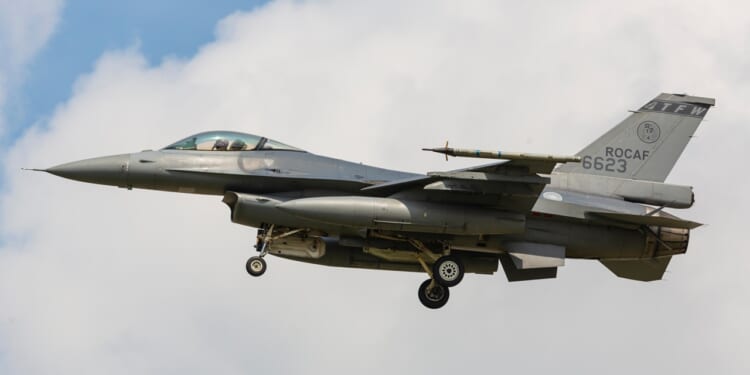Lockheed Martin is expected to complete its F-16V deliveries to Taiwan by 2028—a full year after China is thought to be prepared for an attack on the island.
Aerospace giant Lockheed Martin is reportedly “working overtime” to ensure that there are no further delays with its deliveries of the F-16 Fighting Falcon to Taiwan. The self-ruling island nation was slated to receive 66 of the upgraded F-16V Vipers by the end of next year, but due to supply chain delays and other factors, fewer than a dozen are likely to be delivered in 2026.
According to a report from Reuters, 50 of the Vipers are now under construction, and 10 of those aircraft will undergo flight tests by the end of 2025 and subsequently be handed over to the Republic of China Air Force (RoCAF) sometime in the first half of 2026, with the remainder now expected by early 2028.
The F-16V is the most advanced variant of the single-engine multirole jet fighter, and has been considered a key component of Taipei’s future defense needs.
The F-16V’s (Block 70) Specifications
- Year Introduced: 2023
- Number built: ~23
- Length: 49.3 ft (15.03 m)
- Wingspan: 31 ft (9.45 m)
- Weight (MTOW): ~48,000lbs (21,772kg)
- Engines: One Pratt & Whitney F100-PW-229 afterburning turbofan engine
- Top Speed: Mach 2.0+ (~1,500 mph, 2,414 km/h)
- Range: ~1,740 nmi (2,002 mi, 3,220 km)
- Service Ceiling: ~50,000 feet (15,240 m)
- Loadout:
- One M61A1 Vulcan 20mm cannon
- Nine hardpoints, including six under wings, two on wingtips, and one under fuselage. Two additional locations under the fuselage for pods
- Crew: 1–2, depending on variant
Lockheed Martin’s Plants Are Firing on All Cylinders
To meet the demand, the aerospace firm has ramped up production at its Greenville, South Carolina, facility. The Taiwanese Ministry of Defense announced that production of the aircraft now includes two shifts, with the manufacturing lines running 20 hours per day.
“I think that we all hope the greatest amount of effort can be exerted to speed up the deliveries,” said Taiwanese Minister of Defense Wellington Koo in an address to lawmakers.
The first of the F-16 Block 70 was unveiled at a ceremony in Greenville in March. That aircraft, serial number 6831, is a two-seat “D” variant that serves as a combat trainer, capable of performing combat missions with a weapons system officer (WSO).
The new aircraft will have a service life of 12,000 flight hours, compared to 8,000 of the older models.
The 66 new F-16 Block 70 fighters will further enhance the capabilities of the RoCAF—which completed its “Phoenix Rising” program, the upgrade of its existing fleet of 144 F-16A/B aircraft to the F-16V standard.
The older aircraft were outfitted with an AN/APG-83 AESA radar, a sniper targeting pod, a Link 16 data link, and a new helmet-mounted cueing system. The Fighting Falcons also received structural upgrades to the wings, fuselage, and landing gear, thereby extending the aircraft’s operational life.
Taiwan Is Preparing for Imminent Chinese Attack
The F-16Vs are several military platforms that Taipei already views as crucial to counter a potential invasion from the People’s Republic of China (PRC), which considers the self-governing island of Taiwan as a breakaway province that will be brought back under mainland control—by force if necessary.
The island of Taiwan, formerly known as Formosa, has had a tumultuous history. Once part of Imperial China, it was ceded to Japan in 1895 as part of the peace settlement of the First Sino-Japanese War. After Japan lost World War II, the island was returned to China, then known as the “Republic of China” under the Kuomintang (Nationalist Party) of Chiang Kai-shek. Four years later, the Kuomintang lost the Chinese Civil War to the Chinese Communist Party (CCP) under Mao Zedong, and Chiang and the remnants of the Kuomintang fled to Taiwan, keeping the Republic of China alive.
Although the CCP has never ruled over Taiwan, it has insisted that its government has rightful ownership of the island. There are fears it will use force in an attempt to gain control of Taiwan in the near future, with analysts suggesting that the People’s Liberation Army (PLA) will be ready to mount an invasion as early as 2027.
Beijing currently outspends Taipei by roughly a factor of 10 on defense. Yet even as the gap widens, advanced aircraft like the F-16Vs could help ensure that the CCP understands that any invasion will be costly and deadly.
About the Author: Peter Suciu
Peter Suciu has contributed over 3,200 published pieces to more than four dozen magazines and websites over a 30-year career in journalism. He regularly writes about military hardware, firearms history, cybersecurity, politics, and international affairs. Peter is also a contributing writer for Forbes and Clearance Jobs. He is based in Michigan. You can follow him on Twitter: @PeterSuciu. You can email the author: [email protected].
Image: Shutterstock / ChenHao_Kuo.


















